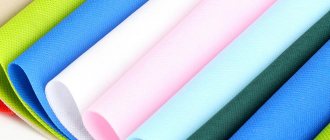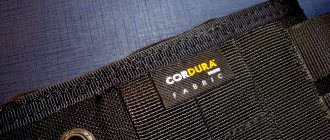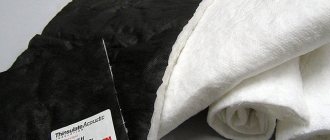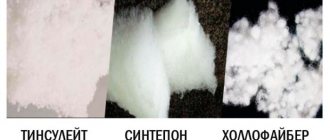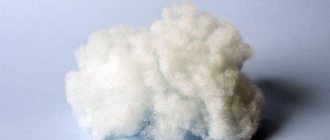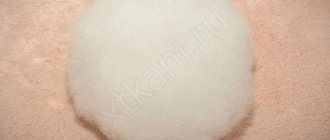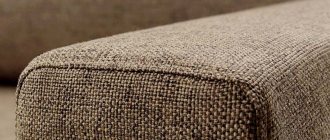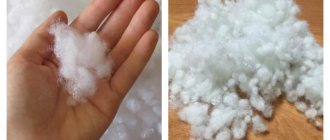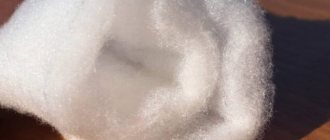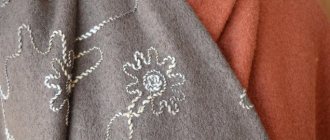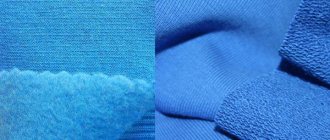The climatic features of Russia dictate to the population questions about protecting their own bodies from cold and wind in the autumn-winter period. Changeable winds and sudden changes in temperature are typical even for the middle zone of our country. In such a climate, you especially want to stay warm. Our ancestors wore fur coats - heavy, long and clumsy. In the 21st century, fur coats have been replaced by modern materials that allow you to warm yourself comfortably.
How to choose the right material to make a warm item pleasant to wear? What material to choose so that the quality of outerwear is at a high level? It should be taken into account that, in addition to thermal qualities, the material must have durability , resistance to frequent washing and elasticity, because the consumer should not feel constrained. All these questions are addressed primarily to the filling for outerwear.
Origin story
The material first appeared in the 1960s and was used only in astronautics. NASA placed an order to develop an innovative filler that could retain heat even in extreme conditions (it is very cold in outer space and astronauts need additional insulation). The matter was entrusted to an American company, so the name “thinsulate” is formed from two English words: “thin” - thin, “insulation” - thermal protection.
The developers created a non-woven material in the 70s, it met the presented requirements and could actually retain heat for a long time due to its fiber structure. Air was better retained between them, which kept the cold away from the body. Unlike down jackets, Thinsulate was comfortable to wear even in a spacesuit because it is very thin.
Only a decade passed - and Thinsulate began to enter other areas. It began to be freely sold along with other fillers, so tailors began to actively use this material in their work. Already 20 years after the start of sales, insulation has become one of the most popular fillers for down jackets, jackets and sportswear.
Manufacturing Features
The fiber is synthetic because it is made from polyesters. Polyesters are organic polymers, so they are completely safe for human health. In addition, they are used to produce many other common synthetic fabrics and fillings.
To obtain polyester fibers, polyethylene terephthalate, a type of thermoplastic, is heated under industrial conditions. It is melted and the resulting mass is formed into threads that are almost invisible to the eye - their size is only 5 microns, which is 5 thousandths of a millimeter! Together they form a weave of fibers that looks like an elegant web. They are located randomly relative to each other so that there is enough space between the threads to retain air - this is the secret of thermal insulation.
Description and composition
Thinsulate is a thin non-woven material that, at first glance, looks like bio-down, but is thinner. It can be sold wrapped on both sides or on its own. There are also quilted fabrics, to which the filling is already sewn on the reverse side - this is done for the convenience of the seamstress, to make her work easier.
Another name for insulation is artificial swan down. Its fibers seem to be twisted in a spiral, so Thinsulate is easily confused with other fillers. At the same time, it is superior to its analogues, because it can maintain temperatures down to -60 degrees.
The material is of chemical origin, but despite this, it is the most hypoallergenic of all insulation materials. Allergy sufferers are not afraid of it and are actively used in the production of children's clothing. For example, children's overalls with Thinsulate not only completely protect against the cold, but are also thin and light and do not hinder the baby's movements.
Advantages
To understand why this relatively new insulation successfully competes with traditional, time-tested materials, it is enough to make a comparison.
- Isosoft is a Belgian invention, which is a layered insulation consisting of two barrier fabrics with a synthetic fiber lining, twisted into tiny balls. The structure of the insulation allows it to retain its shape and volume, withstand use well, and the shell protects it from falling out. In terms of thermal conductivity, Isosoft is significantly superior to synthetic winterizer and is practically no different from Thinsulate. With similar characteristics, the American material is more versatile - it is also used as a filler, while Isosoft is a target insulation.
- Thermofinn is a domestic development that has absorbed the best qualities of foreign analogues. Consists of a combination of conventional and two-component synthetic fibers. The material is homogeneous, airy, soft, holds volume well, and is quite warm. Although it is still new to the insulation market, its thermal conductivity and performance characteristics make it possible to displace synthetic winterizer and get closer to Thinsulate.
- Hollofiber is a type of synthetic fiber insulation that belongs to modern developments. It has a homogeneous, porous structure, holds its shape perfectly, does not crumble or become thin during use. It is superior to outdated materials, but inferior to Thinsulate in terms of thermal conductivity and basic properties. However, it has wider application and is cheaper, which somewhat equalizes the chances. Read more about prices for holofiber at the link.
- Down is a natural insulation material, which for many is associated with clothing of the same name. Initially, down jackets were indeed filled with this type of bird cover, but over time it lost its relevance. Down is warmer than holofiber, but inferior to Thinsulate; in addition, it does not tolerate washing and active wear, losing volume and ability to retain heat during use. In addition, fluffs have an unpleasant feature - they strive to crawl out even through the thickest fabric, which also worsens the performance.
Which of the above materials is considered the best depends on the specific situation. If down has disadvantages characteristic of natural insulation, synthetics are free from this. Holofiber, isosoft, and thinsulate are high-quality, universal materials with a decent set of properties.
Confirmation of the quality of Thinsulate insulation.
Characteristics and properties
Benefits of Thinsulate:
- Due to the peculiarities of the fiber weave, it retains warm air well, as a result of which this filler is warmer than its analogues.
- Air circulates freely, which allows the skin not to sweat.
- Thinsulate items are light and compact.
- The fibers do not retain odors, so the filler will not become saturated with sweat or other unpleasant odors.
- The spiral-shaped fastening of the threads together allows the filler to be elastic, so the clothes will not hamper movement.
- The material is safe for allergy sufferers and children, although it is of synthetic origin.
- Upon contact with fire, it does not ignite, but begins to melt. Some types are treated with fire-resistant impregnations.
- It does not absorb dust and is not a suitable environment for the proliferation of microorganisms.
- When it rains, it gets wet for a long time and dries quickly afterwards.
- Wear-resistant, practically does not deform during wear and washing.
- Does not require special care conditions - you can easily wash it at home or take it to the dry cleaner.
Disadvantages of the filler:
- It is difficult to paint, so it is sold only in white.
- It is electrified (like any synthetic material).
- It may be uncomfortable in case of warming during the daytime (the thinnest filler is designed for +5 degrees).
- Thinsulate clothing is expensive.
Is it possible to wash jackets and down jackets with Thinsulate in a washing machine?
Faced with the need to clean winter clothes with a new type of filling for the first time, many do not know whether Thinsulate can be washed in a washing machine and what programs are suitable for this purpose. If the information on the product label is insufficient or missing, you should adhere to the following machine wash rules:
- Preliminarily inspect the clothing for complex stains, heavy dirt, and also make minor repairs if necessary.
You must zip your jacket before washing.
- Pockets, zippers, and rivets should be fastened, making sure that no objects remain inside.
- A jacket, trousers or down jacket with Thinsulate should be washed inside out.
- The detergent must be suitable for washing delicate fabrics made from synthetic fibers, be liquid and not contain chlorine bleaches.
- The choice of program depends on the model of the washing machine; usually it is a delicate, hand wash mode or intended for the care of synthetic fabrics.
- It is better to load only one down jacket or jacket into the washing machine drum at a time. This is especially true for bulky items.
- Thinsulate practically does not come off during washing, but for prevention you can add a few tennis balls.
- You can leave the spin, but move the regulator to a position that corresponds to 300–400 rpm.
- Be sure to add a rinse cycle, which is included in the automatic washing machine, to completely remove any remaining detergent remaining between the Thinsulate fibers.
After washing, the product is removed from the washing drum, slightly shaken and hung to dry on flat, wide hangers.
We recommend:
Why does laundry smell musty after washing?
Advice! To prevent rust from appearing in the area of rivets or zippers, you can lubricate the metal parts with wax or seal them with clear tape.
Types by density, based on temperature
The difference between the types of Thinsulate lies in the cold weather this material can be worn in. You can calculate how warm the insulation will be using density tables. The material is produced from 100 to 400 units per square meter - the higher the number, the warmer it will be in such a jacket or down jacket.
100-150 grams per square meter is used for demi-season jackets and coats, which are designed for temperatures of +5-0 degrees, they can be worn down to -10 along with a warm jacket. 200-300 grams will protect even from harsh temperatures of -20-30 degrees, and denser insulation up to 400 grams. can withstand even -60! 300-400 gram Thinsulate is used to make overalls for workers, climbers and astronauts - this material is so warm.
Varieties and differences
Thinsulate comes in three varieties:
- Without shell. This is a thin sheet material, the fibers of which are held together with a special glue that does not break down from washing and wear. It is used for sewing jackets, coats and other outerwear - it is sewn between the outer fabric and the lining.
- Shell on one side. Jackets are also made from this type of Thinsulate, but it needs to be additionally quilted approximately every 20 cm. The shell here is located on the lining side and is needed in order to reduce the wear of the insulation. The lining is usually quite thin, so due to close contact with the body, the filling may fray after some time. In addition, the additional layer of material will provide greater heat retention.
- Shell on both sides. This Thinsulate already has a stitch every 20cm, so there is no need for a seamstress to do this work. The easiest material of the three to sew, because the insulation is simply attached to the seams of the product. It is easy to cut and does not fray during sewing. It wears out slower than others and heats better due to additional layers of material.
In addition to this division into types, the manufacturing company produces 4 series of insulation for different clothes.
Platinum
You will recognize this series by the black and gray tags. It is also divided into several types and is used mainly for sewing sportswear and overalls for workers:
- Flex. Used for sewing insulated tracksuits and other clothes that are very elastic.
- X-Static. A special feature of the material in this series is threads with ions, which prevent pathogenic bacteria from multiplying. Relevant if you have to sweat a lot in these clothes.
- FR. Possesses fire-resistant qualities.
Warmth plus Additional Features
This is clothing for active recreation: fishing, tourism, etc., which can also be used as everyday wear.
- Thin, light, warm. “Thin, light, warm” - this is how the name of this type of Thinsulate is translated. One of the first in the line.
- Extra Warmth. Thicker and more voluminous - you can most often see fluffy down jackets made from this insulation.
- Thinsulate with recycled fibers. People who care about the ecology of our planet will support the direction of this series - clothing made from such Thinsulate contains fibers from recycled materials. The material does not lose its warm properties because of this, and the processing is not noticeable from the outside. This could be, for example, gloves for workers.
- Ultra for footwear and the similar Ultra Extreme Performance series are used in the production of footwear.
Featherless
The company's development is the closest to natural fluff. This filler has completely adopted all the positive properties from its ancestor, and does not lose them even when wet. The clothes are easy to wash, they can withstand high temperatures and dry cleaning, so these products are suitable for everyday wear.
LiteLoft
A special feature of this series is the company’s new development – mixing thin and thick fibers in the filler. Thick threads create more volume, while thin threads still allow for better air retention. This innovation made it possible to create clothes and shoes that wear out less, because the insulation quickly returns to its original state after compression.
What should a buyer choose, Thinsulate or Holofiber?
Holofiber is one of the varieties of padding polyester, but of better quality. It has a lower density than synthetic winterizer and higher thermal protection properties . Environmental safety allows it to be used in the manufacture of blankets and clothes for very young children. Holofiber can also be found in different thicknesses and qualities.
Thinsulate and holofiber have a common quality - they retain heat well; in terms of heat-saving properties, both are close to natural down. Both are lightweight and quickly regain their shape after compression . Both materials do not cause allergies and are environmentally friendly, not afraid of water.
Application of material according to its marking
When buying Thinsulate, pay attention to the labeling of each material. This filler differs not only in density, but even in composition and special properties (for example, one type is fire-resistant). Each marking can be of different densities.
| Marking | Thickness(cm) | Density (g/m2) | Compound | Peculiarities |
| WITH | 0,3-1,75 | 40-263 | Polyolefin 65%, polyester 35% | Classic Thinsulate, the thinnest available |
| R | 1-2,1 | 101-230 | Polyester 100% | Cheaper than others |
| TIB | 1,7-2,5 | 98-191 | Polyester 95%, polyolefin 5% | Larger than others |
| IN | 0,2-0,8 | 105-420 | Polypropylene 88%, polyester 12% | Quickly returns to previous form |
| FR | 1,2-1,8 | 120-200 | Meta-aramid 65%, acrylonitrile 20%, polyethylene styrene 15% | Refractory |
Ideal insulation: what is good about Thinsulate, how to choose it and work with it
What is Thinsulate?
Thinsulate™ is a modern synthetic insulation material used, among other things, for sewing clothes. In terms of its qualities, Thinsulate is superior to many natural and synthetic insulation materials: it is very warm, while occupying a small volume, moisture-resistant, durable and easy to care for. Today it is called the warmest thin insulation for clothing. Thinsulate was developed by the American company 3 M (by the way, it was the company that invented adhesive tape in the 1920s); the material was released onto the market in 1979.
“Heat should be felt, not seen.” Slogan 3 M Thinsulate on an advertising poster in the hunting and fishing magazine Field and Stream, September 1988
At first, Thinsulate was used to insulate special clothing, and then it began to be used in the production of shoes and all kinds of outerwear, both casual and sports. Today, Thinsulate is used by companies that sew clothes (including luxury brands), plus you can buy it to insulate something you sew yourself.
How to choose insulation for sewing clothes
What is good about Thinsulate?
seattlefabrics.com
+ Excellent thermal insulation properties without excess volume
3M claims that Thinsulate is at least twice as warm as any natural material. It is warmer than many modern synthetic materials. The fact is that Thinsulate fibers are very thin, much thinner than polyester fibers, which are usually used in synthetic insulation. In addition, these fibers are very dense. Due to this thinness and density of the fibers, Thinsulate is both warm and not too bulky. It retains body heat well and keeps out the cold outside.
+ Moisture resistance
Thinsulate is moisture resistant - its fibers absorb less than 1% of moisture from their own weight, while natural insulation materials can absorb up to 70%. Even if Thinsulate is slightly wet by this 1 percent, its thermal insulation properties do not change. Dries quickly.
+ Ability to keep shape, while being flexible
The product retains its heat-insulating abilities and does not lose its appearance after repeated washing and folded storage. When wearing a thing, the insulation in it does not migrate, that is, it remains in its place, does not bunch up, or slide down. At the same time, things with Thinsulate are comfortable and ergonomic.
+ Hypoallergenic and increased hygienic properties
Unlike natural insulation materials, Thinsulate does not cause allergies.
+ Easy to use and maintain
Thinsulate is easy to work with and items with it do not require special care (more about the features of work and care below).
Based on the combination of these qualities, Thinsulate is called an ideal insulation: indeed, it is one of the best modern thermal insulation materials.
Trend of the season: quilted jackets and vests
What is Thinsulate?
closetcorepatterns.com
At the moment, the Thinsulate trademark is a whole family of materials, the properties of which may differ slightly or quite significantly. There are different classifications of Thinsulate, we will focus on the one offered by the material manufacturer, and we will mention those varieties that are easier to buy and use for home sewing.
* Thinsulate types C (Classic)
The thinnest type of the entire line, good for demi-season items and accessories, for insulating clothes with a close-fitting silhouette. Thickness from 0.3 to 1.75 cm, density from 40 to 263 g/m2. Consists of polyophelin (65%) and polyester (35%) fibers. C - without interlining, CS - with one-sided interlining (maximum panel size without quilting is 30x45 cm, for larger panels quilting is done at intervals of 10-25 cm), CDS - with double-sided interlining (quilting step 15 cm).
* Thinsulate P
Insulation in a double-sided “shell” with embossed stitch type (does not require quilting). The advantages of Thinsulate Type P: no migration of fibers, strength and wear resistance. The most economical material among all types and the best in terms of heat/weight ratio. Created specifically for children's clothing, but can be used for any clothing, including professional ones. Thickness from 1 to 2.1 cm, density from 101 to 230 g/m2. Consists of 100% polyester.
* Thinsulate G/KL
Created specifically for insulating sports and professional clothing (jackets, vests, hats, gloves, etc.). Type G is able to maintain its original shape even under heavy loads and prolonged wear, and is inexpensive. Available in different thicknesses and densities, it is 100% polyester.
* Thinsulate J
This type of Thinsulate is particularly elastic and soft, and is therefore positioned as an alternative to down. Also, its feature is its increased ability to repel moisture. The density and weight vary, the composition is 100% polyester.
* Thinsulate TIB
Specially designed for creating regular and quilted blankets, blankets, bedspreads and sleeping bags. Also used for sportswear. Voluminous, lightweight and breathable. Thickness from 1.7 to 2.5 cm, density from 98 to 191 g/m2. Composition: polyester 95%, polyolefin 5%. It is recommended to use high-quality down-proof fabrics with this material; the recommended thread count is at least 270 threads.
There is also a special Thinsulate for insulating shoes (type B), fire-resistant Thinsulate for workwear (Type FR) and so on. Most often on sale at retail you can find type P, all three of its modifications: P 100, P 150, P 230 (the number indicates the density of the material), and types C (C, CS and CDS - of different densities). But you can find other varieties.
We wash jackets and down jackets
How to choose Thinsulate?
closetcorepatterns.com
* When purchasing, the seller does not always provide information about the labeling of the material, which we wrote about above. In any case, focus on the volume of the material (how well it fits the chosen model) and density. The manufacturer does not provide a clear gradation between density and minimum temperature, indicating that the ability of a thing to protect from the cold depends on the insulation, the base material, the type, thickness and number of thermal packages, and the weather itself, for example, humidity and wind. According to the experience of needlewomen who worked with Thinsulate, a density of up to 100 g/cm2 is designed for temperatures up to -10 - -15 degrees, 150-200 g/cm2 - for temperatures up to -20 - -25 degrees. Take into account how you plan to spend time in your item, because with less activity we get colder than with high activity, and how cold you usually get.
* Thinsulate can be without a non-woven pad or with a pad on one or both sides. When choosing the type of insulation, keep in mind that the gasket, among other things, provides wind protection: material without a gasket is suitable for models made of windproof fabrics.
* You can use one or more layers of Thinsulate - the second option is possible if, for example, only a thin type of insulation is available.
Fabrics in alphabetical order
How to work with Thinsulate: recommendations from the manufacturer
closetcorepatterns.com
* When quilting, the heat-protective qualities of Thinsulate (like any material) deteriorate. The manufacturer recommends laying quilting lines at a distance of at least 10-12 cm from each other. If the model provides for a smaller distance between the lines, then it is recommended to use two layers of insulation or a denser modification.
* The parts of the quilted lining are usually joined using a topstitch or a topstitch.
* The insulation pad is light and thin, so, as a rule, it does not need to be cut out of the sections; it is enough to simply overcast them.
* Ironing with an iron whose sole temperature is more than 60 °C is strictly not recommended for Thinsulate: the fibers will melt and the material will lose its properties. Do not iron Thinsulate with steam in the usual way (more on the possibility of using steam below).
* It is recommended to carefully iron the product before connecting it to the insulation. The final wet-heat treatment should be carried out on a steam dummy, or with a steam generator, or with an iron with a “vertical steam” function.
How to make a quilted lining
How to wash Thinsulate and care for products containing it?
* Wash Thinsulate at 40 degrees (some types, in particular P, allow washing at 60 degrees).
* Do not bleach products containing Thinsulate.
* Low temperature machine drying is acceptable for most types.
* Gentle dry cleaning is permitted.
* Ironing at a temperature not exceeding 60 degrees, only without using steam.
DIY quilted coat with insulation (Part 1)
DIY quilted coat with insulation (Part 2)
Comparison with other insulation materials
Despite the fact that Thinsulate is compared to swan's down, the artificial material is much warmer. If you take a jacket with the same thickness of insulation, it turns out that down is one and a half to two times cooler than thinsulate.
Thinsulate is superior to other types of fillers due to its unique features:
- it is thinner than other types of insulation, so such clothes are lighter and more pleasant to the body;
- there are a lot of filler fibers, which creates a large area of contact with air - it is better retained inside;
- Thinsulate threads are so thin that they form weaves reminiscent of a spider web - more warm air can be retained in the free cavities;
- the total surface area of the fibers is 10 times greater than other fillers.
Rules for drying, smoothing and storage
Washing a jacket with Thinsulate using the recommendations given is quite simple. All that remains is to properly dry the product, smooth it if necessary, and put it away for summer storage at the end of the season. Clothes with synthetic fillers, which include Thinsulate, dry very quickly; the main thing is to hang things on wide hangers and ensure good ventilation and warmth in the room. You should not hang jackets near heating appliances, or speed up the drying process.
Winter items are stored either in clothing cases in a vertical position, or packed in vacuum bags, avoiding excessive compression. Before the start of the cold season, jackets are first shaken to straighten the thinsulate, and then, if necessary, smoothed with an iron or vertical steamer. You can iron things with this filler, but in order not to damage the outer fabric, you should use lining material.
Products with Thinsulate are light, warm, beautiful and durable. By properly caring for your clothing, you can enjoy the excellent appearance and thermal properties of your jackets for a long time.
Care instructions
A special feature of Thinsulate is that it is practically not picky about the conditions of care. But it’s still worth knowing what temperature to set the washing machine mode to and what powder to use.
How to wash down jackets and Thinsulate jackets
Products with filling should be washed at a temperature no higher than 60 degrees, otherwise the glue connecting the fibers may deteriorate. In this case, the item will become unusable. How many degrees this particular item can withstand is often indicated on the product tag.
When washing, it is not recommended to use powder, but to purchase a liquid product - it is more efficiently washed out of the fibers. Set the spin cycle to minimum; it is better to let the water drain from the item into the bathtub or basin on its own. Machine drying is allowed only in a gentle mode, but it is better to do it outdoors.
How to dry and iron correctly
In order not to deform the product, it should be hung on hangers over a bathtub or basin. Make sure that there are no heating devices nearby - the fibers may melt if they come into contact with them. For the same reason, ironing is not allowed.
What it is
Thinsulate filler is used in various products, reviews will help us get an idea of what it is
Igor, 29 years old: I have winter boots on this insulation. What I especially like is that they are surprisingly light, much lighter than the same sheepskin. And of course, they warm perfectly, even when by chance you have to stand in the cold, your feet don’t freeze at all in these shoes
Vera, 38 years old: I sew unusual gloves to order - this is my hobby. For winter options, it is very difficult to choose insulation so that there is no damage to the design and cut, but this is not about Thinsulate. This material is thin, light and very comfortable, which means it will be comfortable with gloves.
Vasily, 45 years old: I really like winter fishing. I’ve been doing this for a long time and I know firsthand that wearing warm gloves or mittens is very inconvenient to manipulate fishing line. But gloves with new insulation that appeared recently are a completely different matter; they are thin, but at the same time quite warm
Olga, 41 years old: A simple children's knitted hat, complemented with Thinsulate - and you will forget about bulky hats. It looks absolutely like autumn, and the scalp breathes in it. Sometimes kindergarten teachers swear that I dress my child too easily in the cold. I have to explain!
The page contains not only reviews about Thinsulate insulation, but also a selection of photos.
